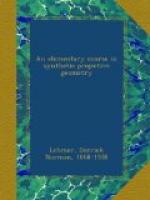19. Space system. Space of three dimensions, considered as made up of all its planes and points, is then a fundamental form of the third order, which we shall call a space system.
20. Lines in space. If we join the twofold infinity of points in one plane with the twofold infinity of points in another plane, we get a totality of lines of space which is of the fourth order of infinity. The totality of lines in space gives, then, a fundamental form of the fourth order.
21. Correspondence between points and numbers. In the theory of analytic geometry a one-to-one correspondence is assumed to exist between points on a line and numbers. In order to justify this assumption a very extended definition of number must be made use of. A one-to-one correspondence is then set up between points in the plane and pairs of numbers, and also between points in space and sets of three numbers. A single constant will serve to define the position of a point on a line; two, a point in the plane; three, a point in space; etc. In the same theory a one-to-one correspondence is set up between loci in the plane and equations in two variables; between surfaces in space and equations in three variables; etc. The equation of a line in a plane involves two constants, either of which may take an infinite number of values. From this it follows that there is an infinity of lines in the plane which is of the second order if the infinity of points on a line is assumed to be of the first. In the same way a circle is determined by three conditions; a sphere by four; etc. We might then expect to be able to set up a one-to-one correspondence between circles in a plane and points, or planes in space, or between spheres and lines in space. Such, indeed, is the case, and it is often possible to infer theorems concerning spheres from theorems concerning lines, and vice versa. It is possibilities such as these that, give to the theory of one-to-one correspondence its great importance for the mathematician. It must not be forgotten, however, that we are considering only continuous correspondences. It is perfectly possible to set, up a one-to-one correspondence between the points of a line and the points of a plane, or, indeed, between the points of a line and the points of a space of any finite number of dimensions, if the correspondence is not restricted to be continuous.
22. Elements at infinity. A final word is necessary in order to explain a phrase which is in constant use in the study of projective geometry. We have spoken of the “point at infinity” on a straight line—a fictitious point only used to bridge over the exceptional case when we are setting up a one-to-one correspondence between the points of a line and the lines through a point. We speak of it as “a point” and not as “points,” because in the geometry studied by Euclid we assume only one line through a point




